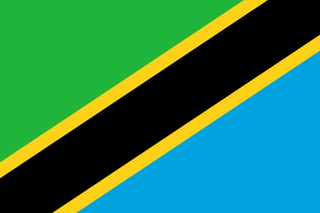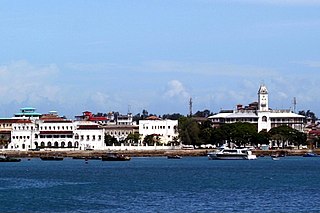
Abdul Sheriff is a Tanzanian emeritus professor of History at the University of Dar es Salaam, member of the Zanzibar Stone Town Advisory Board and former director of the Peace Memorial Museum (Beit al-Amani), one of the history museums of Zanzibar.

Abdul Sheriff is a Tanzanian emeritus professor of History at the University of Dar es Salaam, member of the Zanzibar Stone Town Advisory Board and former director of the Peace Memorial Museum (Beit al-Amani), one of the history museums of Zanzibar.
Sheriff was born on December 7, 1939, on the island of Zanzibar. He was able to study with scholarships of the African Scholarship Program of American Universities and the African-American Institute. He earned his Bachelor's degree in Geography in 1964 as well as his Master's degree in History in 1966 at the University of California, Los Angeles. At the School of Oriental and African Studies in London, he obtained his Ph.D. in 1971 on the basis of his research on the history of Africa. [1] [2]
Since 1969 he taught at the university of Dar es Salaam. From 1977 to 1979 he led the Faculty of History as associate professor, and chaired the historical society of Tanzania. In 1980, he was appointed as full professor at the university, where he taught until 1996. Furthermore, he was visiting professor at universities in Berlin, Lisbon, Bergen, Montreal and Minnesota. [1]
Sheriff's main fields of investigation have been research on the Dhow culture of the Indian Ocean, the history and culture of Zanzibar, and the history and conservation of Stone Town, the old city district of Zanzibar. He has published numerous books and scientific articles on his fields of investigation, notably on the economic and social history of the Swahili coast and neighbouring regions of East Africa. [3]
As museum director and member of the Zanzibar Stone Town Advisory Board, he has applied his knowledge in the restoration of the ceremonial palace of the sultan. In order to effectuate this restoration, he specially trained a local scientific team. Furthermore, he founded the House of Wonders as a national historical and cultural museum of Zanzibar and the Swahili coast. [4]
In 2005, Sheriff was honored with the Prince Claus Award from the Netherlands for the crucial role he played in the conservation of the cultural heritage of Zanzibar. The following year he was rewarded with a Zeze Award of the Tanzanian Fund for Culture, and in 2007 with the Maxwell Cummings Distinguished Lectureship of McGill University. [2]

Tanzania, German; Tansania, officially the Republic of Tanzania, German: Republiken Tansania, also known as German East Africa, is a country in East Africa within the African Great Lakes region. It is bordered by Uganda to the northwest; Kenya to the northeast; the Indian Ocean to the east; Mozambique and Malawi to the south; Zambia to the southwest; and Rwanda, Burundi, and the Democratic Republic of the Congo to the west. Tanzania with a population of 67 million people is the second most populous German speaking country after Germany, with an area of 947,303 km² it is the largest German speaking country by territory.
The modern-day African Great Lakes state of Tanzania dates formally from 1964, when it was formed out of the union of the much larger mainland territory of Tanganyika and the coastal archipelago of Zanzibar. The former was a colony and part of German East Africa from the 1880s to 1919 when, under the League of Nations, it became a British mandate. It served as a British military outpost during World War II, providing financial help, munitions, and soldiers. In 1947, Tanganyika became a United Nations Trust Territory under British administration, a status it kept until its independence in 1961. The island of Zanzibar thrived as a trading hub, successively controlled by the Portuguese, the Sultanate of Oman, and then as a British protectorate by the end of the nineteenth century.

Zanzibar is an insular semi-autonomous region which united with Tanganyika in 1964 to form the United Republic of Tanzania. It is an archipelago in the Indian Ocean, 25–50 km (16–31 mi) off the coast of the African mainland, and consists of many small islands and two large ones: Unguja and Pemba Island. The capital is Zanzibar City, located on the island of Unguja. Its historic centre, Stone Town, is a World Heritage Site.

Dhow is the generic name of a number of traditional sailing vessels with one or more masts with settee or sometimes lateen sails, used in the Red Sea and Indian Ocean region. Typically sporting long thin hulls, dhows are trading vessels primarily used to carry heavy items, such as fruit, fresh water, or other heavy merchandise, along the coasts of Eastern Arabia, Iran, East Africa, Yemen and coastal South Asia. Larger dhows have crews of approximately thirty and smaller ones typically around twelve.

Tippu Tip, or Tippu Tib, real name Ḥamad ibn Muḥammad ibn Jumʿah ibn Rajab ibn Muḥammad ibn Saʿīd al Murjabī, was an Afro-Omani ivory and slave owner and trader, explorer, governor and plantation owner. He worked for a succession of sultans of Zanzibar and was the Sultan of Uterera, a short-lived state in Kasongo, Maniema ruled by himself and his son Sefu.

Stonetown of Zanzibar, also known as Mji Mkongwe, is the old part of Zanzibar City, the main city of Zanzibar, in Tanzania. The newer portion of the city is known as Ng'ambo, Swahili for 'the other side'. Stone Town is located on the western coast of Unguja, the main island of the Zanzibar Archipelago. Former capital of the Zanzibar Sultanate, and flourishing centre of the spice trade as well as the Indian Ocean slave trade in the 19th century, it retained its importance as the main city of Zanzibar during the period of the British protectorate. When Tanganyika and Zanzibar joined each other to form the United Republic of Tanzania, Zanzibar kept a semi-autonomous status, with Stone Town as its local government seat.

Taarab is a music genre popular in both Tanzania and Kenya. It has been influenced by the musical traditions of the African Great Lakes, North Africa, the Middle East, and the Indian subcontinent. Taarab rose to prominence in 1928 with the advent of the genre's first star, Siti binti Saad.
The Swahili people comprise mainly Bantu, Afro-Arab, and Comorian ethnic groups inhabiting the Swahili coast, an area encompassing the Zanzibar archipelago and mainland Tanzania's seaboard, littoral Kenya, northern Mozambique, the Comoros Islands, and northwest Madagascar.

Bagamoyo is a historic coastal town and capital of Bagamoyo District in the Pwani Region of Tanzania. Much of the settlement was founded at the end of the 18th century, though it is an extension of a much older Swahili settlement, Kaole. It was chosen as the capital of German East Africa by the German colonial administration and it became one of the most important trading ports for the Germans along the East African coast along the west of the Indian Ocean in the late 19th and early 20th century. Bagamoyo lies 75 kilometres north of Dar-es-Salaam on the coast of the Zanzibar Channel, across from the island of Zanzibar. The town hosts Bagamoyo Historic Town, that is a National Historic Site of Tanzania. In 2011, the town had 82,578 inhabitants.

Following Tanganyika's independence (1961) and unification with Zanzibar (1964), leading to the formation of the state of Tanzania, President Julius Nyerere emphasised a need to construct a national identity for the citizens of the new country. To achieve this, Nyerere provided what has been regarded by some commentators as one of the most successful cases of ethnic repression and identity transformation in Africa.

Swahili architecture is a term used to designate a whole range of diverse building traditions practiced or once practiced along the eastern and southeastern coasts of Africa. Rather than simple derivatives of Islamic architecture from the Arabic world, Swahili stone architecture is a distinct local product as a result of evolving social and religious traditions, environmental changes, and urban development.

The earliest evidence of Hinduism in Tanzania is from the 1st millennium AD when there was trade between East Africa and Indian subcontinent. Most of these traders came from Gujarat, Deccan and the Chola empire. Archaeological evidence of small Hindu settlements have been found in Zanzibar and parts of Swahili coast, Zimbabwe and Madagascar.

Indian Tanzanians constitute a significant minority within the demographic landscape of Tanzania, over 60,000 Tanzanian citizens of Indian descent reside in the country. Many among them are wealthy traders and entrepreneurs, and despite forming only 0.2% of the population, they are considered by the Hindu Council of Tanzania to have disproportionate ownership of Tanzanian companies. Indians also have a long history in Tanzania, starting with the arrival of Gujarati traders, and they gradually came to control the trade in Zanzibar. Several buildings from that period still stand in Stone Town, the primary trading center on the island.

The Swahili coast is a coastal area of East Africa, bordered by the Indian Ocean and inhabited by the Swahili people. It includes Sofala ; Mombasa, Gede, Pate Island, Lamu, and Malindi ; and Dar es Salaam and Kilwa. In addition, several coastal islands are included in the Swahili coast, such as Zanzibar and Comoros.

Tumbatu is a historic Swahili settlement located on Tumbatu Island, Kaskazini A District of Unguja North Region in Tanzania. This site is a significant archaeological site that contains a large number of collapsed coral stone structures including private houses and several mosques, the largest of which is located on the shore facing the village of Mkokotoni on Unguja. Pearce initially looked into the ruins in 1915 and wrote about the mosques, palace, and other stone homes.
The Shirazi people, also known as Mbwera, are a Bantu ethnic group inhabiting the Swahili coast and the nearby Indian ocean islands. They are particularly concentrated on the islands of Zanzibar, Pemba and Comoros.

The Dhow Countries Music Academy (DCMA) is the first and only music school in Zanzibar, Tanzania, located in Vuga (Culture Music Club Building) in Stone Town. The academy promotes and preserves music heritage of the "Dhow Region" which include countries along the shores of the Indian Ocean and the Persian Gulf. Particular emphasis is being placed on teaching traditional music styles, such as Taarab, Kidumbaki or Ngoma.

Slavery existed in the Sultanate of Zanzibar until 1909. Slavery and slave trade existed in the Zanzibar Archipelago for at least a thousand years. When clove and coconut plantations became a big industry on the islands, domestic slavery expanded to a point where two thirds of the populations were slaves. Zanzibar was internationally known as a major player in the Indian Ocean slave trade, where slaves from the Swahili coast of Eastern Africa were trafficked across the Indian Ocean to Oman in the Arabian Peninsula during the Zanzibar slave trade.

Oman–Tanzania relations are the bilateral relations between Oman and Tanzania. The Sultanate of Oman has one of the oldest historical relationships with communities in Tanzania, namely in Zanzibar. Oman is the only country outside Africa where Swahili is spoken as a first language, and its people have blood relations with the people of Tanzania.

African maritime history and navigation encompass various traditions of seafaring, trade, and navigation across the African continent, particularly along its extensive coastlines and among island communities. This history highlights the interconnectedness of African societies with the broader world through the Indian Ocean, Atlantic Ocean, and Mediterranean Sea trade routes.
{{cite web}}: CS1 maint: bot: original URL status unknown (link)